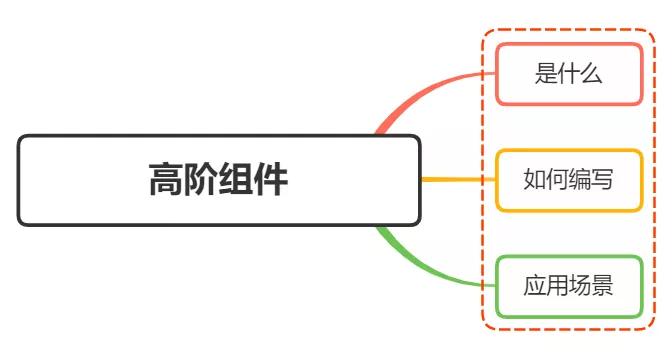面試官:說說對高階組件的理解?應用場景?
本文轉載自微信公眾號「JS每日一題」,作者灰灰。轉載本文請聯系JS每日一題公眾號。
一、是什么
高階函數(Higher-order function),至少滿足下列一個條件的函數
- 接受一個或多個函數作為輸入
- 輸出一個函數
在React中,高階組件即接受一個或多個組件作為參數并且返回一個組件,本質也就是一個函數,并不是一個組件
- const EnhancedComponent = highOrderComponent(WrappedComponent);
上述代碼中,該函數接受一個組件WrappedComponent作為參數,返回加工過的新組件EnhancedComponent
高階組件的這種實現方式,本質上是一個裝飾者設計模式
二、如何編寫
最基本的高階組件的編寫模板如下:
- import React, { Component } from 'react';
- export default (WrappedComponent) => {
- return class EnhancedComponent extends Component {
- // do something
- render() {
- return <WrappedComponent />;
- }
- }
- }
通過對傳入的原始組件 WrappedComponent 做一些你想要的操作(比如操作 props,提取 state,給原始組件包裹其他元素等),從而加工出想要的組件 EnhancedComponent
把通用的邏輯放在高階組件中,對組件實現一致的處理,從而實現代碼的復用
所以,高階組件的主要功能是封裝并分離組件的通用邏輯,讓通用邏輯在組件間更好地被復用
但在使用高階組件的同時,一般遵循一些約定,如下:
- props 保持一致
- 你不能在函數式(無狀態)組件上使用 ref 屬性,因為它沒有實例
- 不要以任何方式改變原始組件 WrappedComponent
- 透傳不相關 props 屬性給被包裹的組件 WrappedComponent
- 不要再 render() 方法中使用高階組件
- 使用 compose 組合高階組件
- 包裝顯示名字以便于調試
這里需要注意的是,高階組件可以傳遞所有的props,但是不能傳遞ref
如果向一個高階組件添加refe引用,那么ref 指向的是最外層容器組件實例的,而不是被包裹的組件,如果需要傳遞refs的話,則使用React.forwardRef,如下:
- function withLogging(WrappedComponent) {
- class Enhance extends WrappedComponent {
- componentWillReceiveProps() {
- console.log('Current props', this.props);
- console.log('Next props', nextProps);
- }
- render() {
- const {forwardedRef, ...rest} = this.props;
- // 把 forwardedRef 賦值給 ref
- return <WrappedComponent {...rest} ref={forwardedRef} />;
- }
- };
- // React.forwardRef 方法會傳入 props 和 ref 兩個參數給其回調函數
- // 所以這邊的 ref 是由 React.forwardRef 提供的
- function forwardRef(props, ref) {
- return <Enhance {...props} forwardRef={ref} />
- }
- return React.forwardRef(forwardRef);
- }
- const EnhancedComponent = withLogging(SomeComponent);
三、應用場景
通過上面的了解,高階組件能夠提高代碼的復用性和靈活性,在實際應用中,常常用于與核心業務無關但又在多個模塊使用的功能,如權限控制、日志記錄、數據校驗、異常處理、統計上報等
舉個例子,存在一個組件,需要從緩存中獲取數據,然后渲染。一般情況,我們會如下編寫:
- import React, { Component } from 'react'
- class MyComponent extends Component {
- componentWillMount() {
- let data = localStorage.getItem('data');
- this.setState({data});
- }
- render() {
- return <div>{this.state.data}</div>
- }
- }
上述代碼當然可以實現該功能,但是如果還有其他組件也有類似功能的時候,每個組件都需要重復寫componentWillMount中的代碼,這明顯是冗雜的
下面就可以通過高價組件來進行改寫,如下:
- import React, { Component } from 'react'
- function withPersistentData(WrappedComponent) {
- return class extends Component {
- componentWillMount() {
- let data = localStorage.getItem('data');
- this.setState({data});
- }
- render() {
- // 通過{...this.props} 把傳遞給當前組件的屬性繼續傳遞給被包裝的組件WrappedComponent
- return <WrappedComponent data={this.state.data} {...this.props} />
- }
- }
- }
- class MyComponent2 extends Component {
- render() {
- return <div>{this.props.data}</div>
- }
- }
- const MyComponentWithPersistentData = withPersistentData(MyComponent2)
再比如組件渲染性能監控,如下:
- class Home extends React.Component {
- render() {
- return (<h1>Hello World.</h1>);
- }
- }
- function withTiming(WrappedComponent) {
- return class extends WrappedComponent {
- constructor(props) {
- super(props);
- this.start = 0;
- this.end = 0;
- }
- componentWillMount() {
- super.componentWillMount && super.componentWillMount();
- this.start = Date.now();
- }
- componentDidMount() {
- super.componentDidMount && super.componentDidMount();
- this.end = Date.now();
- console.log(`${WrappedComponent.name} 組件渲染時間為 ${this.end - this.start} ms`);
- }
- render() {
- return super.render();
- }
- };
- }
- export default withTiming(Home);
參考文獻
https://zh-hans.reactjs.org/docs/higher-order-components.html#gatsby-focus-wrapper
https://zh.wikipedia.org/wiki/%E9%AB%98%E9%98%B6%E5%87%BD%E6%95%B0
https://segmentfault.com/a/1190000010307650
https://zhuanlan.zhihu.com/p/61711492


























